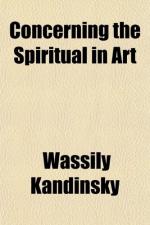These two possible resemblances between the art forms of today and those of the past will be at once recognized as diametrically opposed to one another. The first, being purely external, has no future. The second, being internal, contains the seed of the future within itself. After the period of materialist effort, which held the soul in check until it was shaken off as evil, the soul is emerging, purged by trials and sufferings. Shapeless emotions such as fear, joy, grief, etc., which belonged to this time of effort, will no longer greatly attract the artist. He will endeavour to awake subtler emotions, as yet unnamed. Living himself a complicated and comparatively subtle life, his work will give to those observers capable of feeling them lofty emotions beyond the reach of words.
The observer of today, however, is seldom capable of feeling such emotions. He seeks in a work of art a mere imitation of nature which can serve some definite purpose (for example a portrait in the ordinary sense) or a presentment of nature according to a certain convention ("impressionist” painting), or some inner feeling expressed in terms of natural form (as we say—a picture with Stimmung) [Footnote: Stimmung is almost untranslateable. It is almost “sentiment” in the best sense, and almost “feeling.” Many of Corot’s twilight landscapes are full of a beautiful “Stimmung.” Kandinsky uses the word later on to mean the “essential spirit” of nature.—M.T.H.S.] All those varieties of picture, when they are really art, fulfil their purpose and feed the spirit. Though this applies to the first case, it applies more strongly to the third, where the spectator does feel a corresponding thrill in himself. Such harmony or even contrast of emotion cannot be superficial or worthless; indeed the Stimmung of a picture can deepen and purify that of the spectator. Such works of art at least preserve the soul from coarseness; they “key it up,” so to speak, to a certain height, as a tuning-key the strings of a musical instrument. But purification, and extension in duration and size of this sympathy of soul, remain one-sided, and the possibilities of the influence of art are not exerted to their utmost.
Imagine a building divided into many rooms. The building may be large or small. Every wall of every room is covered with pictures of various sizes; perhaps they number many thousands. They represent in colour bits of nature—animals in sunlight or shadow, drinking, standing in water, lying on the grass; near to, a Crucifixion by a painter who does not believe in Christ; flowers; human figures sitting, standing, walking; often they are naked; many naked women, seen foreshortened from behind; apples and silver dishes; portrait of Councillor So and So; sunset; lady in red; flying duck; portrait of Lady X; flying geese; lady in white; calves in shadow flecked with brilliant yellow sunlight; portrait of Prince Y; lady in green. All this is carefully printed in a




